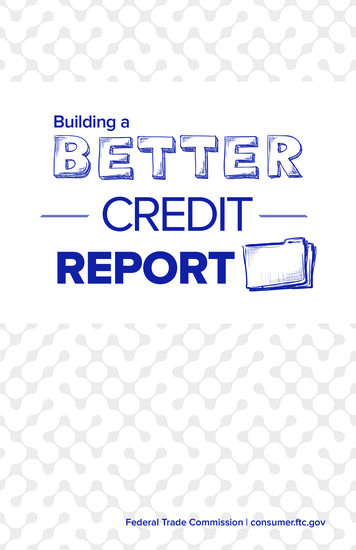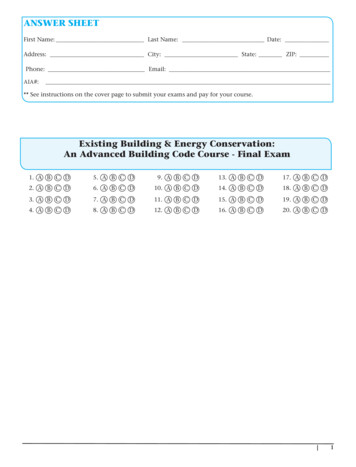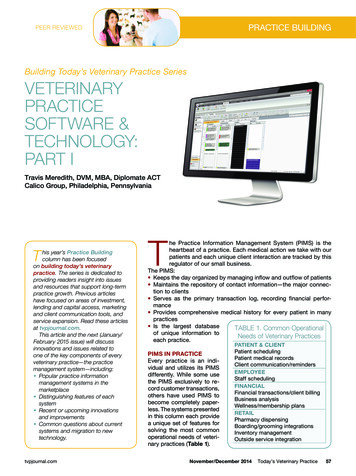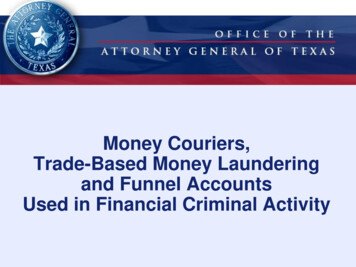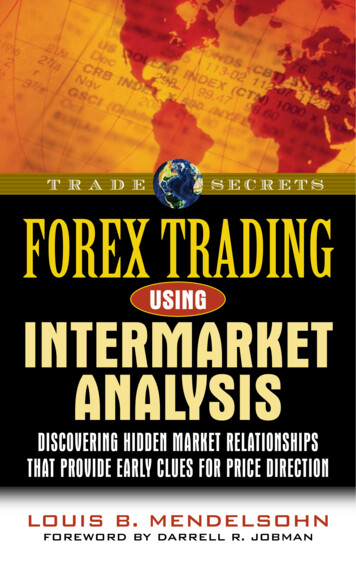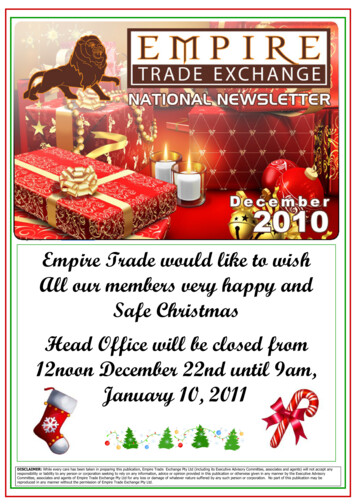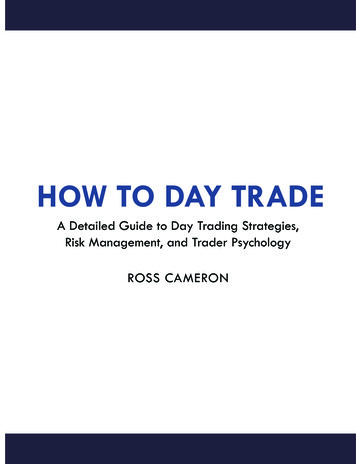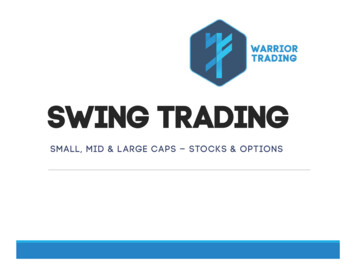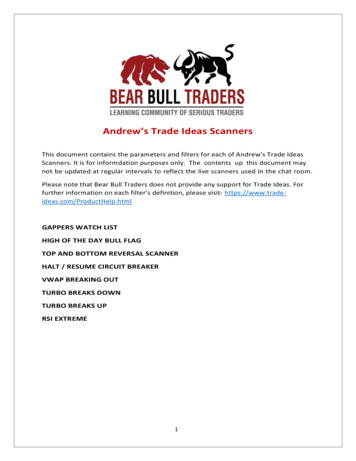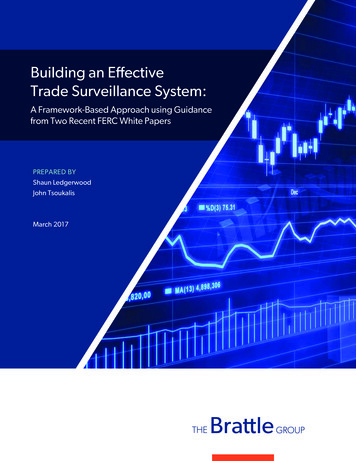
Transcription
Building an EffectiveTrade Surveillance System:A Framework-Based Approach using Guidancefrom Two Recent FERC White PapersPREPARED BYShaun LedgerwoodJohn TsoukalisMarch 2017
TABLE OF CONTENTSExecutive SummaryiiI.Introduction1II.Summary of the Recent FERC White Papers2A. Documentation of Legitimate and Manipulative Trades3B. Trade Monitoring and Surveillance31. Surveillance “Flags”32. Surveillance “Screens”4C. The Need for Audits4III. A Framework-Based Approach to Trade Surveillance5A. A Framework for Analyzing Market Manipulation5B. Forensic Trade Surveillance using the Framework6C. Vetting and Improving Surveillance Screens7D. Real-Time Surveillance Can Increase Profitability8IV. Conclusion10ACKNOWLEDGEMENTWe acknowledge the valuable contributions of many individuals to this report,including members of The Brattle Group for peer review. All views expressed arethose of the authors and not necessarily those of The Brattle Group or its clients.Copyright 2017 The Brattle Group, Inc.
EXECUTIVE SUMMARYTwo white papers published by the staff of the FederalEnergy Regulatory Commission (FERC) in late 2016discuss the need for jurisdictional companies to developtrade surveillance systems as a key component ofdeveloping a “culture of compliance” with respect to theCommission’s anti-manipulation rule.In this paper, we summarize the FERC guidelines, then provide an example of a logicalapproach to building such systems using a framework that we have developed foranalyzing manipulative behavior. Our recommended approach is consistent withthe “effective practices” outlined in staff’s white papers and can be implementedto develop trading compliance procedures in line with those recommended by theFERC.This approach is designed to be implemented in phases, focusing initially on easilyidentifiable behavior that poses the most enforcement risk. This allows a tradingcompany to learn best practices in compliance and develop a broader system as timeand resources will allow. Further, because our approach follows the cause-and-effectof manipulative acts and their resulting benefit to the actor, this approach is broadlyapplicable to other trade surveillance applications, such as for the CommodityFutures Trading Commission (CFTC).ii brattle.com
I. INTRODUCTIONIn November 2016, the FERC Office of Enforcement (OE) released two white paperssummarizing its anti-manipulation enforcement efforts over the last decade (the EnforcementWhite Paper or EWP)1 and articulating staff’s view of effective and ineffective trade compliancepractices (the Compliance White Paper or CWP).2 Together, the papers provide guidance asto the behavior staff sees as indicative of manipulation and suggests best practices for marketparticipants seeking to develop effective trading compliance programs to detect and detersuch behavior. Many of the tasks suggested anticipate that market participants will build anddevelop trade surveillance systems, monitoring trading data either on a forensic basis or inreal-time.Market participants may balk at the notion of putting in place trade surveillance for fear of cost, complexity,disruption of legitimate trading, and the possible self-reporting quandary presented if suspected manipulativebehavior is found (EWP, pp. 36-37). However, the creation of an effective surveillance system need not be afinancial albatross, nor interfere with normal trading operations. To the contrary, if approached as an evolutionaryand incremental process, the development of trade surveillance can provide firms with a cost-effective meansto reduce regulatory risk and increase profitability by broadening the universe of legitimate trades that can beplaced.In cooperation with internal and external counsel, we have used our experience in manipulation-related matters3to help our clients build and implement the trade surveillance systems as described in the white papers. Ourapproach builds on many of the “effective practices” discussed in the CWP to assist clients in cost-effectivelybuilding surveillance systems tailored to their specific needs. This paper summarizes the practices identified byOE and describes the key fundamentals of our approach.Section II provides a short summary of the white papers. Specifically, we show how the effective practicesidentified by OE coalesce into a simple set of flags and screens that can serve as the basis of a trade surveillanceprogram. Section III describes our approach to trading compliance. In it we explain the logical framework weuse to identify and understand manipulative behavior. We then illustrate how our approach is consistent with theeffective practices identified by OE and describe an incremental approach for implementing a trade surveillancesystem.brattle.com 1
II. SUMMARY OF THE RECENT FERC WHITE PAPERSThe recent FERC white papers offer substantive guidance for companies seeking to develop effective complianceprograms. The EWP defines aspects of behavior that OE sees as manipulative and discusses some characteristicsof manipulation that the agency has alleged in its various enforcement actions. These include “indicia of fraud,”which include conduct that serves an illicit purpose, is uneconomic, or is inconsistent with market fundamentals(EWP, pp. 10-15), and various types of market manipulation, including cross-market manipulation schemes, thegaming of market rules, and misrepresentations (EWP, pp. 16-32). Although not as clear-cut as market participantsmight like, these examples inform the types of behavior that the FERC perceives as manipulative and, to a lesserextent, the types of behavior it may view as legitimate.4For example, the “indicia of fraud” identified by OE focus on behavior that is executed not based on its ownstand-alone economics, but for an ulterior motive, such as to increase revenues derived indirectly through crossmarket interactions or out-of-market payments. OE seems to recognize that behavior executed solely to serve astand-alone, legitimate business purpose is lawful, including the use of legitimate hedging (EWP, p. 15, n. 51).However, Compliance should note OE’s currently-aggressive enforcement posture, as stated in its belief that“a manipulative purpose satisfies the scienter element [of the FERC’s anti-manipulation rule] even if combinedwith a legitimate purpose” (EWP, p. 9). We discuss the implications of this “per se” enforcement approach oncompliance in Section III.The CWP complements the EWP by emphasizing the importance of creating “(i) systems and protocols formonitoring, identifying and correcting possible violations, (ii) a management culture that encourages complianceamong company personnel, and (iii) tools and training sufficient to enable employees to comply with Commissionrequirements” (CWP, pp. 2-3). Although staff does not mandate specific elements needed to comprise aneffective compliance program, its recommendations pragmatically distill to: Devoting adequate resources and funding to hire compliance staff with diverse professional backgrounds,vet and train trading staff, and build an IT infrastructure capable of supporting effective trade surveillance(CWP, pp. 6-11);Building documentary processes to codify and inform personnel about permissible versus prohibitedtrading strategies and to review trader communications for potential misconduct (CWP, pp. 12-13, 17);Developing flags and screens for trade surveillance to detect the indicia of potentially problematic tradingand report such concerns to Compliance (CWP, pp. 13-17); andRegularly auditing all compliance systems and processes to assure that they are working properly andidentify the need for upgrades and improvements (CWP, p. 19). Assuming that a firm has chosen to devote adequate resources to developing an effective compliance program,the CWP thus directs the need for documentary retention and review, the monitoring of trade data, and theauditing of the program over time.2 brattle.com
A. DOCUMENTATION OF LEGITIMATE AND MANIPULATIVE TRADESThe white papers encourage compliance personnel to evaluate and record legitimate and prohibited tradingstrategies and review communications and other documents for evidence of potential misconduct, includingillicit purposes (EWP, pp. 10-13). For example, OE notes “[o]ne way to discourage traders from using physicalenergy products to benefit financial positions is to require documentation of all trading strategies that involvetrading related physical and financial products. This documentation should explain the rationale for the strategy(e.g., a hedge) and describe the circumstances under which the strategy might be used” (CWP, p. 13). Once astrategy is recorded and vetted by internal Compliance, future trading based on the strategy requires only thattraders identify the strategy used for each trade employed, with deviations from the strategy allowed only withthe permission of Compliance.The vetting of a trading strategy requires that Compliance is aware of the potentially problematic linkages thatcould arise between the trading at issue, other positions within the trader’s portfolio, and other payments thatmight arise due to the behavior. Vetted strategies must be revisited over time as part of an audit process to assessthe performance of the compliance program and improve its processes given new information (CWP, p. 19).B. TRADE MONITORING AND SURVEILLANCETo simplify the creation of a trade surveillance system, the FERC recommends that market participants shouldapproach the task at the most granular level possible that is relevant to detecting the specific types of behavior ofconcern (CWP, p. 16). This suggests the creation of very simple surveillance tools designed to identify potentialproblems at granular levels (which we refer to as surveillance “flags”) as well as more complex tools designed toidentify more complex behavior (which we refer to as “screens”). We provide guidance on how to implement anduse these tools in Section III.1. Surveillance “Flags”The guidance provided in OE’s white papers informs the creation of what we call “flags” as the foundation forautomated trade surveillance. By “flags” we mean calculations that produce a binary “yes/no” answer in responseto a specific compliance-related question regarding the trading data, for example:there evidence of uneconomic conduct in price-setting instruments? OE states that “[u]neconomic Isconductoccurs when an entity knowingly engages in behavior that loses money on a stand-alone basis—oris indifferent to whether it loses money—but engages in the behavior anyway to serve an ulterior purpose”(EWP, p. 13; see also CWP, p. 13). Hence, “compliance departments at trading companies should considermonitoring and reviewing their traders’ profit and loss calculations, particularly for instances in which atrader is accepting persistent losses in a price-setting product while simultaneously having exposure toa position whose value is tied to such trading.” (EWP, p. 14; see also CWP, pp. 15-16). The flags createdshould therefore test for the profitability of trades on a stand-alone basis at the most granular level possible(CWP, p. 14).5there evidence of a related, speculative price-taking position that could provide a target for Ismanipulation?OE states that “[l]imiting the size of a trader’s open financial position can minimize thetrader’s incentive to try to move a price to benefit his or her financial positions” (CWP, p. 14). Althoughtraders and Compliance should always be aware of the price-taking positions6 in their portfolios, flags canbe created that tie to the direction of each financial position (i.e., long or short) and its size relative to limitsset by Compliance (CWP, p. 14). OE suggests that a key limit is exceeded “[i]f the position in the financialinstrument is larger than for the price-setting instrument” (CWP, p. 15). This ratio is the basis for calculatingfinancial leverage in manipulation cases, as we discuss further below.brattle.com 3
the trading of price-setting products concentrated enough to set prices? OE notes that concentrated Istradingof price-setting products can “have the ability to push a price in a direction that could benefit arelated financial position” and thus trigger a manipulation (CWP, p. 15). Compliance can set flags tied tothresholds on price setting products based on concentration, used as simple alerts or to prevent furthertrading (CWP, p. 14). OE suggests that these flags be adjusted to reflect market dynamics “to account fordiffering liquidity and the market participant’s ability to influence prices” (CWP, p. 15).inaccurate information being provided? If so, is it intentionally being provided for manipulative Ispurposes?While Compliance should assure that accurate information is provided by their firms as a generalmatter, enforcement risk arises when factual misstatements or omissions are purposely used for manipulativepurposes (EWP, pp. 23-32). To combat such concerns, Compliance can monitor or analyze the accuracyof information submitted to market administrators, such as the parameters that comprise a generator’s costbased offer or of the size of gas flow nominations when pipelines constraints bind (CWP, pp. 16-17).2. Surveillance “Screens”Once flags are in place, the FERC foresees that Compliance can create screens that analyze the flags individuallyor in combination to assess whether there is evidence of concerning behavior. For example, it is expected thatlegitimate, profit-seeking trades would occasionally lose money given the normal risks inherent to the market,but it may be abnormal for those losses to last over a period of days, be unusually large, or arise only at times andlocations that could bias a market price or other outcome. Automated screens can look for patterns in the flagsindicative of such anomalies. If detected, the results are reported to Compliance, which then can question thebehavior and/or prevent further trades of concern from o
The recent FERC white papers offer substantive guidance for companies seeking to develop effective compliance . programs. The EWP defines aspects of behavior that OE sees as manipulative and discusses some characteristics of manipulation that the agency has alleged in its various enforcement actions. These include “indicia of fraud,” which include conduct that serves an illicit purpose, is .
